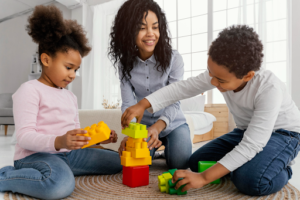What happens when one child’s therapy becomes the family’s new normal, and their sibling is left wondering which parent will pay attention to them?
If you are a parent who is going through ABA therapy with your child, you know it takes a great deal of time, energy, and emotional effort at each step. But what of the other child, the one who stands by and watches it all play out?
In families that have autism and applied behavior analysis as a part of daily life, the sibling relationship can be very rewarding and also very complex. Supporting that intention takes love and some practical tools. That is what this blog is about.
We will look at methods that support strong sibling relationships and help create balance, which at times may not feel like it is present at all.
Why Sibling Relations Need Importance
In many cases, siblings of kids with autism have a range of very different feelings. They may feel very proud of putting forward what they are also working hard to accomplish for their brother or sister. They may also feel guilty, confused, or resentful for wanting more of your time. These are not signs of failure; they are signs of being human.
Families see improvement when they include their siblings in the ABA process in a way that is appropriate for the sibling’s age.
Also, we see that this inclusion, which is sometimes just the sibling feeling valued but other times is a task the sibling does to help out at home, actually also brings out in the child positive behaviors, which creates a more resilient and empathetic child.
The family dynamic as a whole sees improvement as the sibling is made a part of the therapeutic process in a growth-promoting way. Also, what we are finding is that if siblings feel that they have a role in what is going on with their brother or sister, they see that there is a positive impact in the home, which breeds patience and lifelong resilience.
Two Approaches to Strengthening Sibling Bonds
In a home setting of ABA therapy, parents may feel that one child is getting the focus, which may make the other child feel left out or ignored. We have put forth two very simple yet effective strategies that include both siblings in the process in a way that is meaningful and supportive for all.
1. Develop Shared Understanding
Help your brothers and sisters to understand.
- Use age-appropriate language: Younger children need simple explanations like, “Your sister’s brain learns differently, so she’s doing a special kind of learning to help her grow.” For the older one, we have a more open discussion on what autism is and how ABA plays a role in improving life skills.
- Normalize emotions: Tell the siblings that it is ok to feel frustrated or jealous. We aren’t trying to make them feel guilty, but make them feel heard.
- Share what ABA is all about: ABA is all about teaching new skills and rewarding progress. Explaining this helps siblings develop empathy and patience.
- Be open to questions: Encourage the open-door policy on questions. It also increases communication flow and reduces misunderstandings which may arise.

2. Include Them in ABA Sessions
Let them be part of the journey in small ways.
- Invite them to see therapy: Watching their sibling do well is also an exciting and encouraging time. Many families report how this has played out on platforms like Instagram.
- Join structured play or activities: Siblings may join in basic games that encourage sharing, turn-taking, or the use of communication.
- Let them help reinforce success: When they do something great, give them a high five, a hug, or a cheer, which can make them feel included and also shows how much you support them.
- Turn routines into connection points: Whether it’s brushing teeth together or helping with a bedtime story, these small, shared routines can reinforce ABA goals while building closeness.
Practical Strategies to Strengthen Sibling Bonds
1. Structured Play and Rotation of Turns
In a calm, supervised environment, centre-based ABA does very well at teaching.
- Safe playground for skills: In controlled settings, we see turn-taking and cooperative interaction, which is made more clear with visual timers and token boards.
- Sibling as a peer model: Your child can learn from big brother or big sister going first, which is a great way to set an example.
- Visual tools: Timers, visual cues, and basic charts help reduce confusion and keep things fair.
- Real-world link: Fun turn-taking games can help kids develop their patience and social skills at home and in school.
This is a very natural way to integrate autism behaviors into daily activities.
2. Solution Focused Emotional Management
Helping siblings work out their differences is a gift.
- Role-play disagreements: Practice on small-scale scenarios like “can you pass the blue car to your brother”, using the ABA framework and reinforcement.
- Calm first, talk later: Teach basic self-regulation techniques like deep breathing to take a timeout before acting.
- Sibling as early warning: Encourage them to note signs of stress in each other and report calmly.
- Reinforce calm moments: When you notice the sibling making an effort to de-escalate issues between each other or work things out, praise them. This instils in them positive emotional behaviors, which is a part of the behavioral management for autism.
These emotion-based tools help kids deal with big feelings and come out stronger.
3. Shared Quality Time
At times, it is the very basic traditions that hold the most meaning.
- Make meals and movie nights family time because shared rituals promote a sense of belonging.
- Spending one-on-one time with each child shows that love is consistent and for all.
- Join sibling support groups for neurotypical siblings, which connect them to like-minded peers and make them feel like they are with people going through the same thing they are.
You include autism in the fabric of everyday joy and connection.

4. Sibling Peer Support Outside Groups
When we see that we aren’t alone, our burdens lift.
- Explore sibling groups: ABA-inspired meetups or groups in your area are very validating.
- Enjoy a break together: These are for play, sharing and community, not therapy.
- Boost empathy: Connecting with peers also plays a key role in this, which is very much the case in how support groups for siblings of autistic individuals improve family wellness.
5. Parenting and Guidance
Your actions serve as a beacon in your children’s lives.
- Show empathy: Let your children hear you say, “I get it; that was hard.” When your kids are around, you set the example for what is expected of them, which will make them do the same.
- Praise interactions: Celebrate when you see, “You shared your toy, which I love,” with great warmth. We base this on applied behavior analysis and autism reinforcement techniques.
- Home rewards system: points charts and sticker rewards that make good behavior fun.
- Communicate calmly: Use redirection, “first then” strategies, and clear routines, as in ABA, to also include kids.
Through the use of everyday warmth and strategic behavioral approaches, your whole family thrives.
Supporting Siblings at Every Age
Each sibling is unique, and age affects how they respond to their surroundings. A toddler may be taken aback by a brother or sister’s therapy schedule, while a teen may feel the pressure to pitch in more than they can.
| Sibling Age | How to Support Them |
| Toddlers (2–4 yrs) | Let them feel included—invite them to play nearby or copy simple skills like waving or clapping. Offer lots of praise. |
| Young Kids (5–8 yrs) | Explain autism in simple words. Involve them in turn-taking games. Celebrate their kindness with stickers or small rewards. |
| Tweens (9–12 yrs) | Answer their questions openly. Let them observe sessions (if interested) and teach them how their support really helps. |
| Teens (13+ yrs) | Acknowledge their deeper emotions. Invite them to help plan sibling time or attend support groups. Give them space to talk. |
Why Families Trust Willow Reach ABA For ABA Therapy
In terms of ABA therapy choice, what we see is that families are looking for more than just clinical support; they are looking for compassion, flexibility and a true partnership. At Willow Reach ABA, we deliver that.

Here’s what makes us different:
1. In-home ABA Therapy Services
- Therapy is in the home setting.
- Sessions are meant to reduce stress, not to add to it.
- Therapists work with your family’s issues.
- Parents and siblings are included in the process.
2. Center-Based ABA Services
- Structured and predictable environment for social learning.
- One-on-one attention in a sensory-considerate space.
- The setting is supervised.
- Great for generalizing behaviors learned at home.
3. Family-Focused Approach
- Willow Reach ABA puts the communication and involvement of families.
- Parents are given guidance based on autism and behavior analysis.
- Siblings are included in routines, play, and positive reinforcement strategies.
- Strategies that draw from the best of applied behavior analysis and autism for the whole family.
If you are looking for ABA services that include your child and their siblings, Willow Reach ABA is a great option.=
Conclusion
Supporting one child through ASD treatment is a process, but also a chance to draw your whole family closer. When siblings feel included, seen and supported during that process, their bond grows stronger, which brings the whole family together.
Through the use of some intent, a great deal of love, and tools like applied behavior analysis and autism strategies, we nurture relationships that will stand the test of time. These are not just for therapy; they are for building our families.
You do important work every day. Go ahead, gently. The connection you are making now will be the foundation for your children’s best years.
Frequently Asked Questions (FAQs) Related To ABA Therapy
- My child in ABA is progressing, but their sibling is acting out. Could it be related?
Yes, we see that, at times, growth in one child will bring out mixed feelings in the sibling, like jealousy or confusion. It’s important to address their issues and give them a space to be heard without judgement. Emotional overlap is common and manageable.
- Should I tell my child’s sibling exactly what happens in ABA sessions?
You don’t have to go into great detail, but a basic age-appropriate explanation goes a long way in reducing worry or anxiety. Telling just what is necessary makes the sibling feel more included and left in the loop.
- Can ABA strategies be adapted to support the sibling’s emotional needs, too?
Absolutely. In many cases of autism, we see that applied behavior analysis strategies, which include praise, routines, and visual support, are put to use with siblings to help them with large emotions, to understand what is expected of them, and to feel empowered within the family setting.
- How does Willow Reach ABA help with family education beyond therapy?
Willow Reach ABA provides family coaching, sibling involvement tips, and resources that go beyond the child to include the whole home. We see that for the best results, families have to be engaged and informed in the process.
- What does Willow Reach ABA do if a sibling feels resistant or disconnected?
We present easy ways that include watching a play session, joining in a game, or giving out praise for helpful actions. We always respect the siblings’ comfort level and readiness to engage.
Looking for everyday encouragement, helpful tips, and a community that gets what you are going through? Follow us at Willow Reach ABA on Instagram and Facebook. We have support, inspiration and real-life stories that inspire.
